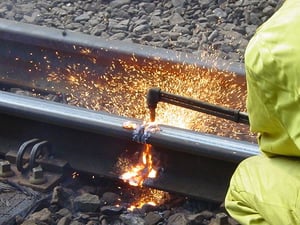Oxy-Fuel cutting is one of the most basic forms of shape cutting sheets of metal. Alongside Laser, Punching, Waterjet and Plasma is is one of the most versatile and cost of effective methods as well as one of the earliest forms of shape cutting has been burning metals. This process, which has been around for over 100 years is still widely utilized today, as it is a very efficient, albeit effective way to carve metals up to 12” thick (and over) into desired shapes for use or further processing.
What is Oxy-Fuel and Oxy-Fuel Cutting?
Oxy-fuel is a combination of flammable gases and an intensifier gas -Oxygen to cut metals. A variety of different flammable  fuels may be utilized, although the most common is Propane. Other gases that can be employed in the processes include: Natural Gas, Acetylene, Hydrogen, Propylene, Liquified Petroleum Gas (LPG), and combinations of these gases. These gasses burn at high temperatures and then are intensified with the addition Oxygen to increase their burning capability.
fuels may be utilized, although the most common is Propane. Other gases that can be employed in the processes include: Natural Gas, Acetylene, Hydrogen, Propylene, Liquified Petroleum Gas (LPG), and combinations of these gases. These gasses burn at high temperatures and then are intensified with the addition Oxygen to increase their burning capability.
Oxy-fuel cutting uses a torch to heat a metal to its melting temperature. At this point, a stream of oxygen is added to the mixture, in turn burning it into a sintered material called Metal Oxide. The oxide then is blown out and away from the material being cut through releasing gas pressures from the cutting process. Any leftover slag that may readhere or not be blown away during this processes can be wiped, tapped or chipped away.
The process itself is rather simplified and can be performed either in a manual application or can be adapted into a CNC motion systems and therefore be used to cut precision shapes .
%20Messer%20MG%20Titan%2012%2010%20Oxy%20Fuel%20Cutting%20System%20-%20Pic%201.jpg?width=600&name=(1683)%20Messer%20MG%20Titan%2012%2010%20Oxy%20Fuel%20Cutting%20System%20-%20Pic%201.jpg)
Multi Headed Oxy-Fuel Cutting System
Comparing Oxy-Fuel to Other Shape Cutting Processes
Alternatives to oxy-fuel cutting include Punching, Plasma, Laser and Waterjet Cutting Systems:
-
Punching - Punching machinery allows for thinner materials to be rapidly processed with common shaped punches. Limited to mostly ¼” capacity and down punching is best utilized when shapes are common throughout the part and some forming is required (Louvers Dimples, Chamfers etc).
-
Plasma - With plasma cutting, the plasma torch blows an inert gas (usually argon or nitrogen) at high speeds and using an electrical arc some of the gasses from a plasma stream providing intense directed heat for cutting. This processes is best suited for materials in the 10 Gage - 2” Thickness range and primarily steel (although aluminum, SS and other materials can be cut as well).
-
Laser - Laser Cutting uses an intensified light source to provide a very small intense heat source to vaporize the material away. Surrounded by gasses to assist the heat and blow out the vaporized material lasers are commonly used in materials less then 1” in thickness and very typically in the gage thickness material.
-
Waterjets - With a waterjet cutter, a mixture of high pressure water (60KPSI) and abrasive is utilized to literally grind through the metal. This method provides no heat or heat affected zone as one of its key benefits.
Each specific shape cutting method method has unique advantages and disadvantages based on the materials utilized, accuracy required and other specific needs for cutting.
Adding the Versatility of Plasma & Oxy-Fuel
Today most manufacturers employ a Plasma cutting system that includes one or more Oxy-Fuel Torches for added capability. Manufacturers will usually employ the oxy-Fuel system on thicker materials in the 2”+ range whereas utilizing the Plasma cutting in play for thinner materials requiring more accuracy.
The experts at Southern Fabricating Machinery Sales, Inc. can help you select the right Oxy-Fuel, combined Oxy-Fuel/Plasma or other process for your needs. Visit us on the web to read more about the Oxy Fuel Cutting Systems Offered and how a quality system from Southern Fab can be the right choice for your shop.
Photos Attributes: By Skatebiker at English Wikipedia
 fuels may be utilized, although the most common is Propane. Other gases that can be employed in the processes include: Natural Gas, Acetylene, Hydrogen, Propylene, Liquified Petroleum Gas (LPG), and combinations of these gases. These gasses burn at high temperatures and then are intensified with the addition Oxygen to increase their burning capability.
fuels may be utilized, although the most common is Propane. Other gases that can be employed in the processes include: Natural Gas, Acetylene, Hydrogen, Propylene, Liquified Petroleum Gas (LPG), and combinations of these gases. These gasses burn at high temperatures and then are intensified with the addition Oxygen to increase their burning capability.%20Messer%20MG%20Titan%2012%2010%20Oxy%20Fuel%20Cutting%20System%20-%20Pic%201.jpg?width=600&name=(1683)%20Messer%20MG%20Titan%2012%2010%20Oxy%20Fuel%20Cutting%20System%20-%20Pic%201.jpg)




